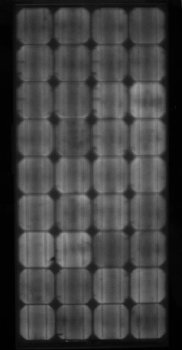Nov 9 2011
With demand for photovoltaic panels more than doubling year on year, manufacturers are under pressure to increase solar cell efficiency, improve production yields, and build capacity. Now, a joint team from the Department of Electrical and Computer Engineering at the National University of Singapore has demonstrated a novel technique to non-destructively test silicon wafer solar cells.
In their research, PhD student Matthew Peloso and his colleagues are developing methods of characterizing solar cells based on luminescence detection and relating this to the electrical properties of the devices. They use an Andor Luca-R Electron Multiplying CCD (EMCCD) camera to image the solar cells and believe the process may be integrated into the production process, helping manufacturers to improve yields and ramp up volume.
 The image above is an entire solar module (1000 x 450 mm) imaged with the Andor Luca-R Electron Multiplying CCD (EMCCD) camera.
The image above is an entire solar module (1000 x 450 mm) imaged with the Andor Luca-R Electron Multiplying CCD (EMCCD) camera.
“We have shown that by controlling the applied voltage inducing electroluminescence in solar cells, the observed spectrum of emitted radiation may be used to identify particular performance-reducing defects”, says Peloso. “Detection of these changes can be used to understand the electrical properties of defects in the wafers and, potentially, to study their origin, which may lead to lower-cost, higher-quality materials for production. Moreover, the method has proven useful at the module as well as the cell level. We demonstrated that breakdown luminescence - which we believe is associated with metallic impurities - does not show a one-to-one relationship with other defect related luminescence signals detected at energies below the silicon bandgap. Interestingly, certain defects did not lead to electrical shunts, which may cause irreversible destruction of PV modules and cells.
“We chose the Andor Luca-R EMCCD camera because of its high red to NIR sensitivity and linear response to intensities, which allows more quantitative data acquisition. The electron multiplying (EM) gain control allowed us to enhance signal to noise when necessary, although we operated much of the time in non-EM gain mode. The Luca-R also provides a good balance of attractive features, including the ability to achieve high integration times and binning, at a lower price compared to other available scientific cameras, such as deep depletion CCD cameras”, he adds.
Dr Colin Coates, Imaging Product Manager at Andor, comments that “Andor’s Luca R makes ultrasensitive EMCCD technology available to this price sensitive application. The megapixel format, enhanced red sensitivity and ability to apply EM gain as required renders Luca R an extremely attractive and versatile camera for characterisation and in-line testing of photovoltaics by electro and photoluminescence.”
Andor’s scientific cameras encompass a wide range of high performance CMOS, CCD, ICCD and EMCCD detectors. To learn more about the Luca camera series and their use in microscopy, please visit the Andor website (http://www.andor.com).